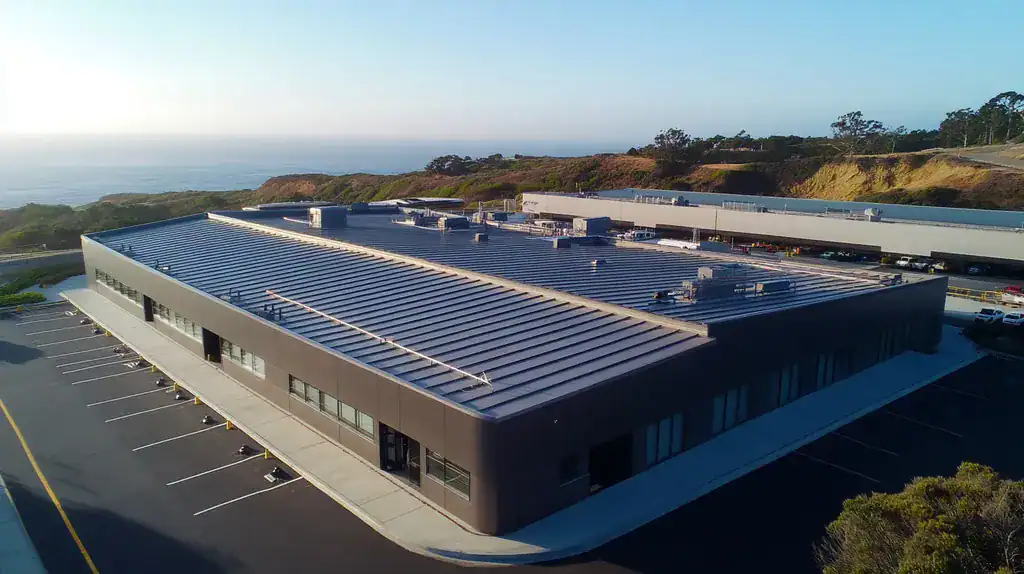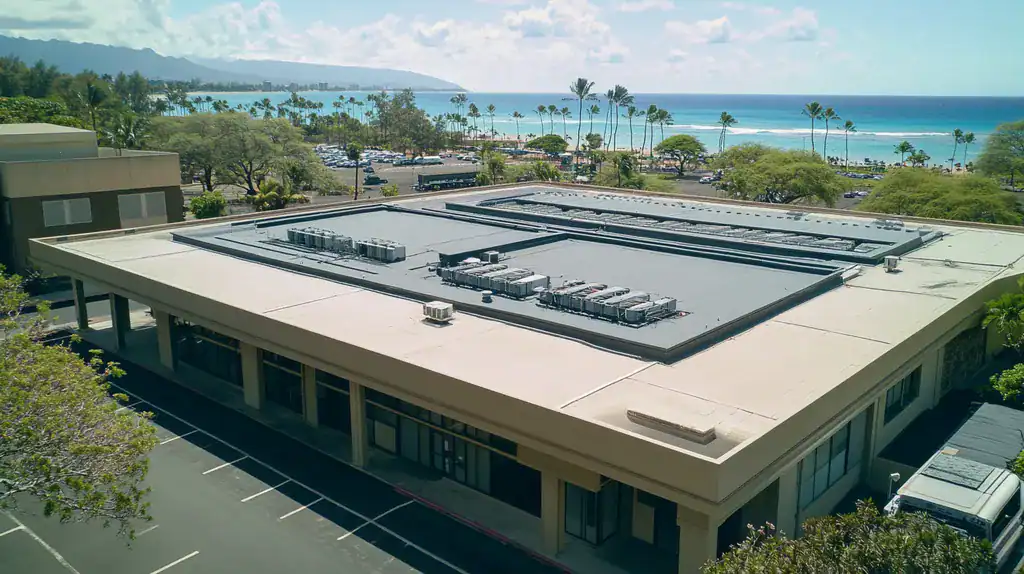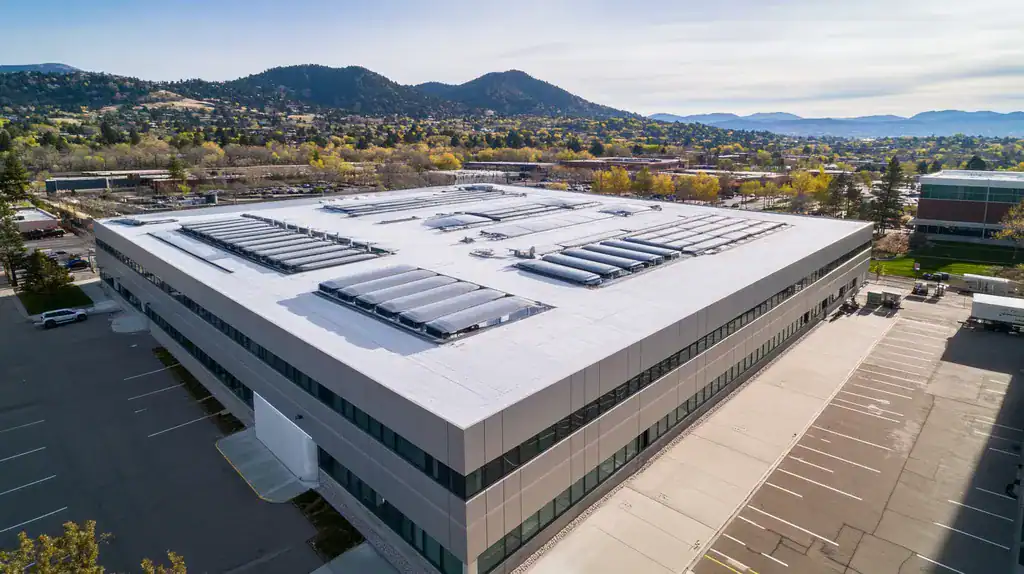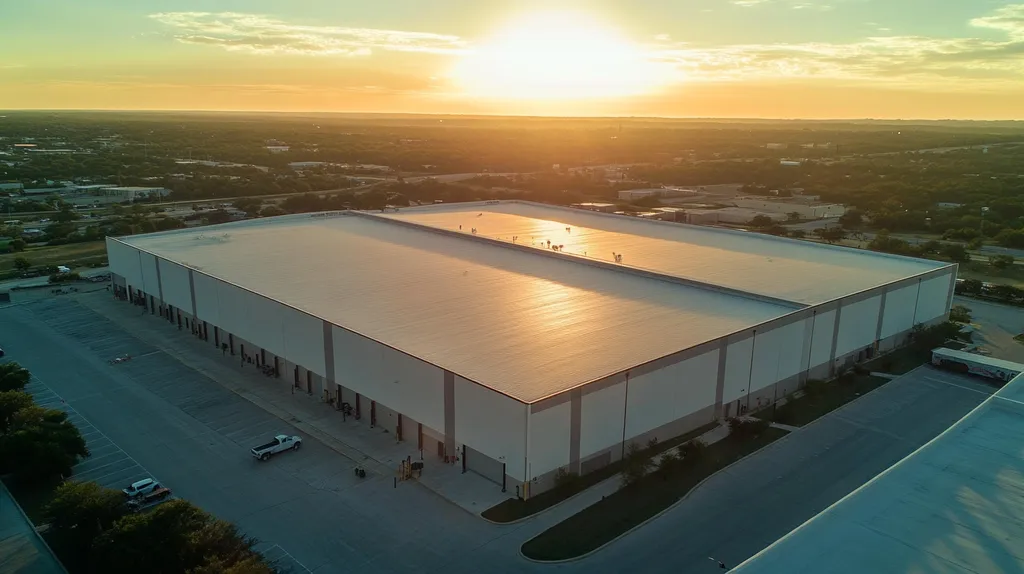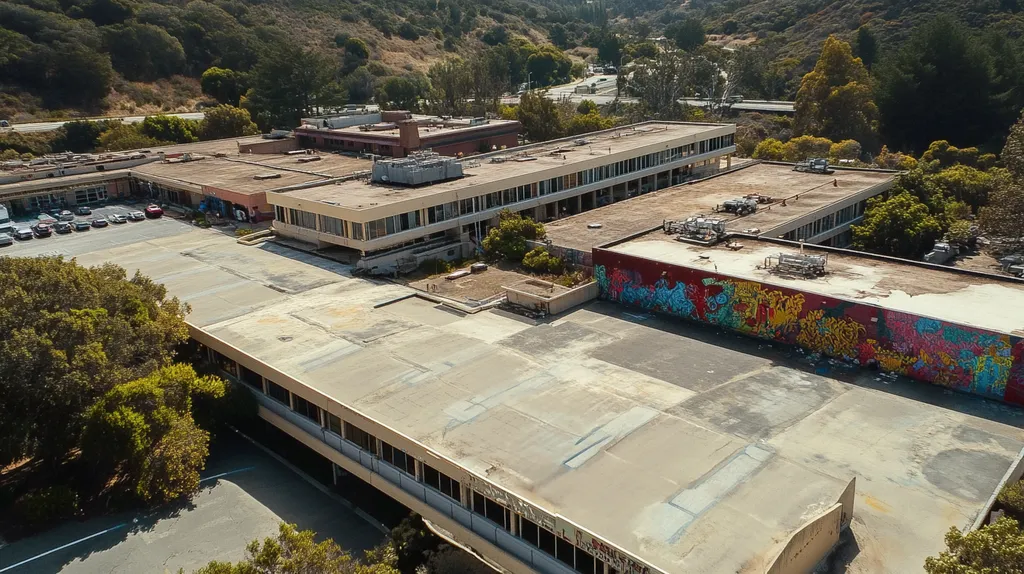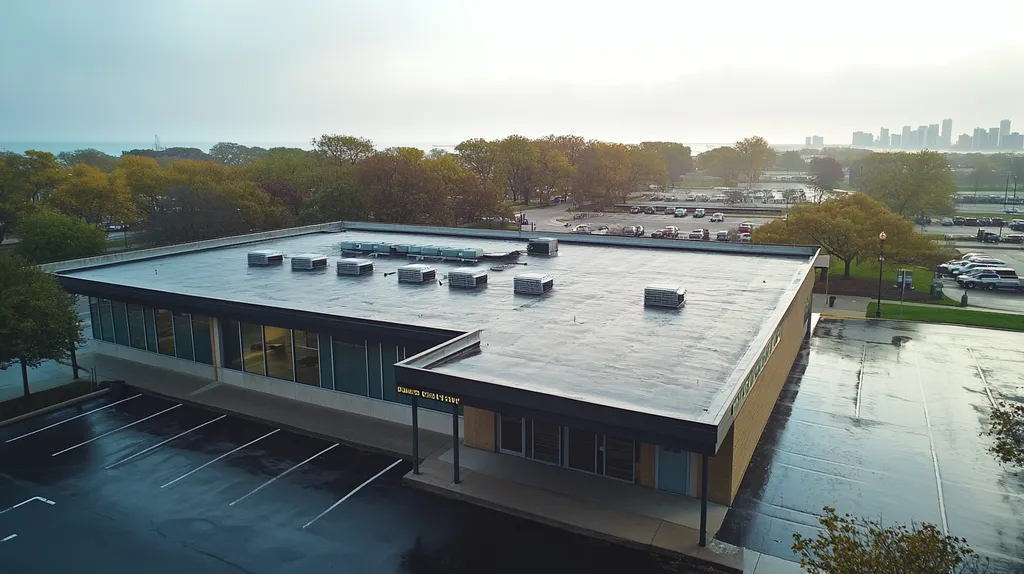Industrial roof leaks cost facilities over $3.3 billion annually in damaged inventory, equipment failures, and operational disruptions, with each hour of delayed response potentially expanding damage zones by 300 square feet.
While 85% of industrial roof leaks occur at predictable vulnerable points, many facilities lack proper emergency protocols to address these critical threats effectively.
This comprehensive handbook provides facility managers and property owners with essential strategies for emergency leak response, from immediate containment through long-term prevention, based on current industry best practices and proven methodologies.
SECTION 1: FUNDAMENTAL CONCEPTS
Industrial roof leaks represent a critical threat to business operations, with potential losses reaching millions of dollars annually in damaged inventory, equipment, and disrupted production. Recent industry data indicates that over 85% of industrial roof leaks occur at predictable vulnerable points, yet many facilities lack proper emergency protocols. Understanding the core principles of leak formation, water infiltration patterns, and emergency response procedures is essential for minimizing both immediate damage and long-term structural deterioration.
Understanding Industrial Roof Leak Causes
The primary triggers for industrial roof leaks stem from three major categories: material degradation, environmental stress, and mechanical damage. UV exposure and thermal cycling gradually weaken roofing materials, creating microscopic pathways for water infiltration.
Design flaws and installation errors account for approximately 30% of industrial roof leaks. Common issues include improper slope calculations, inadequate flashing details, and incompatible material combinations.
Weather-related stressors pose significant challenges, particularly in regions with extreme temperature variations. Freeze-thaw cycles can create expansion cracks, while heavy rainfall tests the limits of drainage systems.
Mechanical damage often results from foot traffic during maintenance activities, dropped tools, or equipment installation. Even minor surface damage can develop into significant leak points over time.
Water Intrusion Pathways and Roof Vulnerabilities
Water intrusion typically follows predictable patterns based on roof system design and construction methods. Seam failures in membrane systems account for roughly 40% of all reported leaks, making these joints primary inspection points.
Penetrations for HVAC units, vents, and utility lines create natural weak points in the roofing system. Each penetration requires specific flashing details and regular maintenance to maintain water-tight integrity.
Edge details and termination points present unique challenges, as these areas experience the highest wind uplift forces. Proper edge securement and regular inspection of coping systems are crucial for preventing water infiltration.
Internal drainage components, including gutters, scuppers, and drain bodies, require particular attention. Blocked or damaged drainage paths can lead to ponding water and increased hydrostatic pressure.
Safety Protocols During Emergency Situations
Effective emergency response begins with clear communication protocols and designated responsibilities. The first priority is establishing a command structure to coordinate response efforts and ensure all team members understand their roles.
Immediate actions should include securing affected areas, redirecting foot traffic, and protecting sensitive equipment. Building systems may need modification, such as closing ventilation systems or adjusting electrical circuits, to prevent secondary damage.
Ongoing monitoring and communication throughout the emergency response is essential for maintaining safety and coordinating repairs. Regular updates help ensure all stakeholders remain informed of situation status and required actions. (source: International Finance Corporation)
Documentation of all emergency response actions serves multiple purposes: insurance claims, future prevention strategies, and refinement of emergency protocols. Detailed records should include timing, actions taken, and observed results.
SECTION 2: SYSTEM COMPONENTS
Industrial roof systems represent complex assemblies where component failure can trigger catastrophic water damage. Industry data shows that 40% of commercial building damage stems from water infiltration, with repair costs averaging $250,000 per incident. Understanding the critical relationship between roofing materials, structural elements, and emergency repair options is essential for protecting facilities and operations from devastating leaks.
Key Roofing Materials and Their Leak Resistance
Modern industrial roofing systems utilize specialized materials engineered for specific performance characteristics. Single-ply membranes like TPO and PVC offer superior resistance to UV degradation and chemical exposure, while maintaining excellent water-tight properties.
Built-up roofing (BUR) systems provide redundant water protection through multiple membrane layers. The combination of bitumen and reinforcing plies creates a robust barrier against water infiltration, particularly suitable for facilities with high mechanical loads.
Modified bitumen systems blend traditional materials with polymer enhancements for improved flexibility and strength. These hybrid solutions offer excellent tear resistance and self-healing properties for minor punctures.
Metal roofing systems deliver exceptional durability and leak resistance when properly detailed. Standing seam designs eliminate through-fasteners and create positive drainage paths, reducing leak potential at connection points.
Critical Roof Elements Affecting Leak Propagation
Penetrations represent the most vulnerable points in any roofing system. Each roof opening requires specific flashing details and waterproofing measures to maintain system integrity.
Structural movement and building settlement can stress roofing components beyond their design limits. Expansion joints and flexible connections must accommodate these forces while maintaining watertight performance.
Drainage patterns significantly influence leak behavior and water accumulation. Positive drainage through properly sized and positioned outlets prevents ponding water and reduces hydrostatic pressure on the roofing system.
Complying with current building codes and seismic design standards significantly reduces leak risks during extreme events. Proper structural reinforcement and wind bracing protect roofing components from displacement and failure. (source: FEMA)
Temporary Repair Materials and Tools Overview
Emergency repair materials must balance immediate effectiveness with long-term compatibility. Specialized roof cements and sealants provide temporary water protection while maintaining the option for permanent repairs.
Reinforced membrane patches offer quick solutions for tears and punctures. Self-adhering materials with compatible adhesive systems prevent further degradation of the primary roof membrane.
Proper application tools ensure effective emergency repairs. Heat welders, seam probes, and moisture meters help technicians identify leak sources and verify repair integrity.
Documentation tools like infrared cameras and moisture meters guide repair efforts. These diagnostic instruments help locate hidden water pathways and verify the effectiveness of emergency measures.
Safety equipment remains essential for emergency response. Fall protection, proper lighting, and communication devices protect workers while enabling swift leak mitigation.
SECTION 3: IMPLEMENTATION METHODS
Industrial roof leaks demand immediate, strategic response to prevent catastrophic damage. Studies show that each hour of delayed action can expand the affected area by up to 300 square feet, potentially compromising structural integrity and business operations. Understanding proper implementation methods – from initial assessment through professional repair – can mean the difference between a minor incident and a major disaster requiring facility shutdown.
Initial Leak Assessment and Damage Containment
The first priority in leak response is establishing a systematic assessment protocol. Begin with interior inspections, mapping visible water damage and tracking moisture patterns to identify potential entry points.
Exterior inspection must follow strict safety protocols, particularly during adverse weather. Use moisture meters and infrared scanning when available to precisely locate water infiltration points that may not be visible to the naked eye.
Immediate containment requires strategic placement of collection vessels and protective barriers. Deploy moisture-resistant tarps to channel water away from critical equipment and inventory while maintaining proper drainage paths.
Document all findings through detailed photography and moisture mapping. Create a clear timeline of when damage was first noticed and how it has progressed to support insurance claims and guide repair strategies.
Step-by-Step Temporary Patching Procedures
Surface preparation is crucial for temporary patch effectiveness. Clean and dry the affected area thoroughly, removing any loose debris or contamination that could compromise adhesion.
Select appropriate temporary patching materials based on the existing roof system. Compatible sealants and reinforced membrane patches provide the most reliable short-term protection when properly installed.
Apply patches using a layered approach, extending well beyond the visible damage area. Ensure complete adhesion and proper overlap with existing roofing materials to prevent water migration under the repair.
Monitor temporary repairs closely during subsequent rainfall, marking any areas where water continues to penetrate. This information proves invaluable for permanent repair planning.
Coordinating Professional Roof Repair Response
A rapid and structured assessment protocol helps determine repair urgency and scope. Evaluate potential hazards like electrical systems and air handling units that could be affected by water infiltration.
Establish clear communication channels between facility management, emergency response teams, and roofing professionals. Regular updates ensure all stakeholders remain informed of situation status and required actions.
Document all emergency response measures taken, including temporary repairs and containment efforts. This information helps roofing contractors understand the full scope of damage and plan appropriate permanent repairs.
Maintain ongoing monitoring throughout the repair process to verify effectiveness and identify any additional issues requiring attention. (source: International Finance Corporation)
SECTION 4: MAINTENANCE REQUIREMENTS
Industrial roof maintenance represents a critical investment, with data showing that neglected roofs fail 70% more frequently than properly maintained systems. Even minor maintenance oversights can cascade into catastrophic leaks, with average repair costs exceeding $100,000 when emergency response is required. Understanding and implementing proper maintenance protocols is essential for protecting both facility assets and operational continuity.
Routine Roof Inspection Techniques for Leak Prevention
Systematic roof inspections require a methodical approach focusing on high-risk areas. Membrane seams, flashings, and penetrations demand particular attention as they account for 85% of leak origins.
Thermal imaging and moisture detection equipment provide critical data about subsurface conditions. These tools can identify moisture infiltration long before visible damage appears, enabling preventive intervention.
Walking pads and designated inspection routes protect the roof surface while ensuring consistent evaluation patterns. Documented inspection paths help track historical problems and identify developing issues.
Environmental factors like UV exposure, chemical emissions, and mechanical stress points require specialized inspection protocols. Each factor demands specific evaluation criteria and documentation methods.
Debris Management and Drainage System Maintenance
Effective drainage maintenance begins with monthly inspections of all water collection points. Strainer baskets, drain bowls, and gutter systems require regular cleaning to prevent blockages.
Ponding water indicates drainage problems that demand immediate attention. Areas retaining water longer than 48 hours face accelerated membrane degradation and increased leak risk.
Vegetation control around roof perimeters prevents organic debris accumulation. Regular trimming of overhanging branches and removal of wind-blown materials protects drainage pathways.
Professional cleaning services should address stubborn deposits and mineral buildup annually. Chemical treatments may be necessary to prevent biological growth that can compromise drainage efficiency.
Emergency Preparedness and Response Plan Development
Every facility requires a documented leak response protocol that clearly defines immediate actions and responsibilities. The plan should identify critical areas, specify containment methods, and establish communication channels.
If water patches appear on ceilings, strategic drainage holes can prevent catastrophic collapse. Proper placement of collection containers and moisture barriers helps minimize structural damage while protecting inventory and equipment.
Electrical systems near leak areas require immediate evaluation and possible shutdown. Quick relocation of sensitive electronics and establishment of safety perimeters prevents secondary damage and workplace hazards.
Response teams need regular training in emergency protocols and equipment operation. Periodic drills ensure efficient execution when real emergencies occur.
Emergency response planning must include rapid access to professional repair services. Swift professional intervention within the first two hours significantly reduces damage extent and repair costs. (source: Weather Shield USA)
SECTION 5: PERFORMANCE METRICS
Industrial roof leak metrics directly impact both immediate response effectiveness and long-term facility protection. Recent data shows that facilities using standardized performance tracking reduce water damage costs by 60% compared to those without metrics. Understanding and implementing proper measurement protocols across severity assessment, repair validation, and response timing provides the foundation for protecting millions in facility assets.
Measuring Leak Severity and Impact on Building Integrity
Leak severity assessment requires quantifiable measurements across multiple parameters. Core metrics include water infiltration rate, spread radius, and structural moisture content, providing objective data for response prioritization.
Advanced monitoring technologies enable precise tracking of leak progression. Infrared mapping and digital moisture meters generate detailed impact zones, while load sensors detect potential structural compromise.
Building integrity metrics must account for both immediate and cumulative effects. Key indicators include insulation saturation levels, deck deflection measurements, and corrosion monitoring at critical connection points.
Documentation through standardized assessment forms ensures consistent evaluation across all leak events. This systematic approach enables trend analysis and helps identify systemic vulnerabilities before catastrophic failure occurs.
Evaluating Temporary Repair Effectiveness
Temporary repair validation requires specific performance benchmarks. Standard metrics include water penetration testing, adhesion strength measurements, and thermal stability under varying conditions.
Real-time monitoring through digital sensors provides continuous effectiveness data. Key parameters include moisture levels beneath repairs, membrane displacement under load, and temperature differential across patched areas.
Durability testing must simulate actual service conditions. Wind resistance, thermal cycling, and impact resistance measurements validate repair integrity under stress.
Systematic documentation of repair performance creates valuable historical data. This information drives continuous improvement in emergency response protocols and material selection.
Tracking Response Time and Repair Completion
Response timing metrics begin with leak detection and notification protocols. Digital tracking systems record key milestones including initial alert, team deployment, and containment implementation.
Critical path analysis identifies bottlenecks in emergency response procedures. Timeline mapping reveals opportunities for process optimization and resource allocation improvements.
Completion metrics must address both immediate stabilization and permanent repairs. Tracking includes containment effectiveness, temporary repair durability, and permanent solution implementation.
Performance data supports continuous protocol refinement and team training. The Federal Emergency Management Agency emphasizes that detailed response metrics enable more effective emergency planning and mitigation strategies. (source: FEMA)
SECTION 6: OPTIMIZATION STRATEGIES
Industrial roof leaks cost U.S. businesses over $3.3 billion annually in damaged inventory, equipment failures, and operational disruptions. Recent industry analyses reveal that 70% of these losses occur in facilities using outdated optimization strategies. By implementing advanced design principles, leveraging predictive technologies, and refining emergency protocols, facilities can reduce leak-related losses by up to 85% while extending roof system lifespan.
Enhancing Roof Design for Improved Leak Resistance
Modern industrial roof design must prioritize water management through integrated system approaches. Enhanced slope calculations, strategic drain placement, and redundant water barriers create multiple layers of protection against infiltration.
Material selection significantly impacts long-term leak resistance. Advanced membrane systems with factory-welded seams reduce field installation variables while providing superior resistance to thermal cycling and UV exposure.
Structural considerations must account for anticipated building movement and settlement patterns. Flexible connections, properly sized expansion joints, and reinforced transition areas maintain system integrity under dynamic loads.
Complying with advanced building codes regarding flood-proofing, seismic design, and wind-bracing significantly improves roof resilience and reduces emergency risks. (source: FEMA)
Integrating Predictive Maintenance Technologies
Advanced monitoring systems now provide real-time data on roof condition and performance. Embedded moisture sensors, strain gauges, and thermal monitoring devices detect potential failures before visible damage occurs.
Drone-based inspection platforms equipped with multispectral imaging capabilities offer unprecedented visibility into developing issues. These systems can identify subsurface moisture accumulation and membrane degradation months before traditional inspections.
Artificial intelligence and machine learning algorithms analyze historical performance data to predict maintenance needs. This predictive approach allows facilities to schedule repairs during planned downtimes, minimizing operational disruption.
Cloud-based monitoring platforms integrate multiple data streams into actionable maintenance recommendations. Remote monitoring capabilities enable rapid response to developing situations while maintaining detailed documentation for warranty compliance.
Continuous Improvement of Emergency Response Protocols
Digital response management systems streamline emergency operations through automated notification chains. These platforms ensure rapid deployment of resources while maintaining clear communication channels between all stakeholders.
Virtual reality training simulations prepare response teams for various leak scenarios. Regular drills using these systems develop muscle memory for critical procedures while identifying potential protocol weaknesses.
Performance metrics tracking response times, containment effectiveness, and damage mitigation success rates guide protocol refinement. Data-driven improvements reduce average response times while increasing first-attempt repair success rates.
Integration with facility management systems enables automated equipment shutdown and environmental control adjustments. This systematic approach minimizes secondary damage while protecting critical operations from water exposure.
The Bottom Line
With industrial roof leaks causing over $3.3 billion in annual losses and each hour of delayed response potentially expanding damage zones by 300 square feet, the stakes for effective emergency protocols have never been higher.
Modern facilities must transition from reactive repair approaches to comprehensive emergency preparedness systems incorporating advanced monitoring technology, rapid response protocols, and preventive maintenance strategies.
By implementing the systematic approaches outlined in this handbook, facilities can reduce leak-related losses by up to 85% while extending roof system lifespan.
The future of industrial roof protection lies in integrated solutions that combine predictive technologies, proven emergency measures, and data-driven optimization to safeguard critical operations and assets.
FREQUENTLY ASKED QUESTIONS
Q. What are common causes of commercial roof leaks?
A. Industrial roof leaks often arise from material degradation, environmental stress, and mechanical damage. Each category contributes uniquely to water infiltration, underscoring the importance of regular inspections and preventive measures to avoid costly repairs.
Q. How do I know if my industrial roof needs repair?
A. Signs your industrial roof needs repair include visible water stains, peeling paint, and missing shingles. Regular inspections and using moisture detection tools will help identify underlying issues before they turn into significant problems.
Q. What steps should I take during a roof leak emergency?
A. In a roof leak emergency, first secure the affected area and redirect foot traffic. Use collection vessels to manage water intrusion, and document the situation thoroughly for future repairs and insurance purposes.
Q. How often should I inspect my commercial roof?
A. Inspect your commercial roof at least twice a year, ideally in spring and fall. Additionally, inspect after severe weather events to address any potential damage quickly and prevent leaks.
Q. Are there specific materials for industrial roof repairs?
A. Yes, use specialized materials such as reinforced membrane patches, sealants, and roof cements for effective repairs. Selecting compatible materials ensures long-lasting performance and prevents future leaks.
Q. How can I optimize my roof maintenance strategy?
A. Implement a proactive maintenance strategy by scheduling regular inspections, employing advanced monitoring, and documenting findings. This approach minimizes risks and extends your roof’s lifespan, ultimately reducing costs.
Q. What is the cost impact of delayed roof repairs?
A. Delayed roof repairs can lead to significantly higher repair costs, potentially expanding the damaged area and compromising structural integrity. Timely interventions prevent escalating expenses and protect facility assets.

